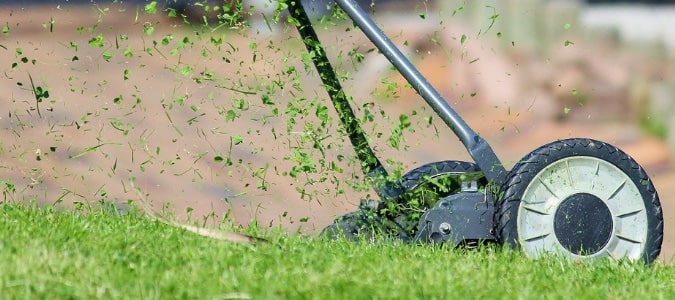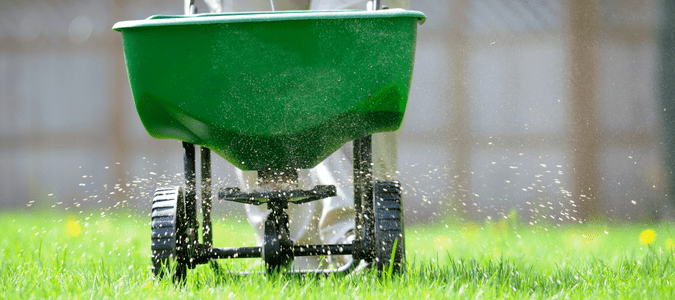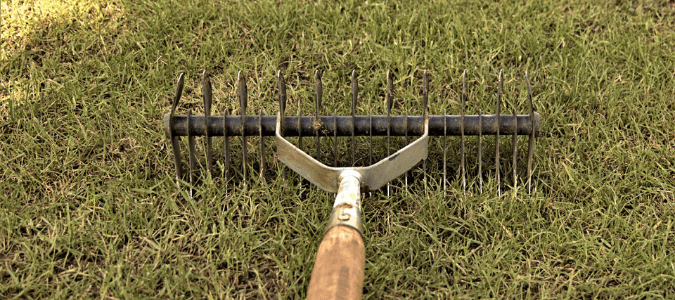Do you know how to properly care for your lawn in the spring? After the long winter months, there are several things you need to do to help bring your lawn back to life.
One important aspect of lawn health is mowing it at the proper time. You do not want to mow your lawn too early in the spring before your grass has time to fully root into the soil. Leaving your grass long until the early spring will encourage deeper root growth.
Fertilizing and watering your lawn at the right time in the spring is also important. Treating your lawn at the wrong time can result in wasted efforts and underdeveloped root systems. Additionally, watering your lawn before the weather is warm enough can damage your grass and sprinkler system.
Finally, it’s important to properly aerate your lawn in the spring. Aerating allows your compacted soil to breathe and take in more nutrients, which helps your grass grow.
When to Mow Lawn in the Spring
After a dormant winter season, it’s important to prepare your lawn for the spring. One of the top concerns homeowners have is not knowing the right time for their first spring cut. Most homeowners consider the length of their lawn as an indication that it’s time to mow, but that’s not all that goes into the decision.
Even if your grass is three or more inches long, it may not be the right time to mow it for the first time that season. You also need to consider temperature. Is it warm enough where you live to mow your lawn consistently?
If cold days, such as temperatures below 40 degrees Fahrenheit, are still predicted, don’t pull out your lawn mower just yet. Wait until the weather is consistently warm before your first cut of the season.
Unfortunately, spring weather is hard to predict. The most important thing is to not mow your lawn after a snowfall or frost. Try to wait until the weather is consistently above 40 degrees.
Another reason to wait until warm weather is to avoid cutting wet or damp grass. Mowing your lawn right after it rains can damage your grass and your lawn mower. Check that the grass is fully dry before you mow.
Follow these tips before you mow your lawn for the first time in the spring:
- Rake your lawn first
- Remove twigs and other debris that accumulated over the winter
- Fertilize your lawn around the same time as the first mow
- If you’re using a weed prevention solution, apply it in the early spring
When you mow, use the setting on your lawn mower that keeps your grass tall. You don’t want to cut your lawn too short in the spring while the grass is still establishing root systems.
Longer grass, around three to four inches, establishes deeper root systems and make it harder for weeds to grow. Each time you mow, you should not remove more than one-third of the blade height of your grass.
If you have questions about caring for your lawn in the spring, contact an expert lawn care specialist. They can create a schedule for your lawn to keep it healthy and beautiful in every season.
When to Fertilize in the Spring
There are two other factors to keep in mind in the spring when it comes to lawn health: fertilizing and watering.
You don’t want to fertilize your lawn too early in the spring season. During that time, your grass is putting all of its energy into rooting into the soil and regrowing. Fertilizing too early will shift the energy into leaf growth, which could result in an underdeveloped root system.
There are several benefits to fertilizing your lawn in the spring, including:
- It helps prevent weed growth
- Fertilizer helps your grass and plants fight diseases
- It provides your grass with needed nutrients to optimize growth
- Ensures your grass grows evenly throughout all areas of your lawn
- It replenishes nutrients and prevents soil runoff
You should fertilize your lawn every six to eight weeks between the spring and fall seasons. Start the cycle with your first fertilization in the late spring, such as in April or May. Your last treatment should be in the late fall just before the cold weather hits.
One rule of thumb is to fertilize your lawn right after you mow it. The nutrients will need to be replenished after the grass is cut, and it’s an easy way to keep track of when to fertilize your lawn. Make sure you fertilize your lawn evenly. Afterward, water your lawn so that the fertilizer sinks down into the soil.
When to Water Lawn in the Spring
Just like with mowing, you want to wait to water your lawn once the threat of frost has passed. This is especially true if you use a sprinkler system since frost can damage your sprinkler lines.
Once it’s warm enough to start watering your lawn consistently, it’s important to water at the right time of the day. Do not water during the warmest part of the day because the sun will evaporate the water before it can soak into the root system. The best time to water your lawn is around 10 am.
If you are unsure about what your lawn needs in the spring, contact a lawn care expert. They can create a lawn care plan that takes into account the best times to water and fertilize your lawn.
Can I Aerate in the Spring?
Another vital part of keeping your lawn healthy and vibrant is properly aerating at the right times. Aerating your lawn is the process of puncturing the earth with spikes to allow for more breathability.
During the winter season, dead roots and other debris clog up your soil and blocks airflow. Aerating your lawn in the spring opens up pathways for your soil to “breathe,” which results in a healthier spring lawn.
Another benefit to aerating your lawn in the spring is relieving soil compaction. Winter temperatures, frost and snow compact soil, which makes it hard for the soil to absorb nutrients in the spring.
Aerating your lawn before your first spring fertilization is a great way to ensure that more nutrients penetrate the soil. It also helps water reach the roots and drain properly.
The best time to aerate your lawn is when your grass is actively growing. This will vary depending on the type of grass you have on your lawn. Cool-season grasses should be aerated in the early spring, while warm-season grasses should be aerated in the late spring season.
There are two ways to aerate your lawn: using the plug method or the spike method. The plug aeration method removes plugs of soil from your lawn, while the spike aeration method uses spikes to poke holes into your lawn.
Both aeration methods can use a variety of tools, including towable tractor attachments, push aerators, handheld tools and aerator boots. There is even a liquid aeration solution.
If you are planning to plant new grass seeds, it’s a good idea to aerate the soil first. Your soil will be more fertile and ready to accept new seeds after aeration. This method is a good way to fill a patch of your lawn will dead grass.
For the best results with aeration, your lawn needs to be at the right moistness. A lawn that is too dry is hard to puncture holes into, and a lawn that is too wet does not achieve the best outcome. Make sure your lawn is properly hydrated before you start aerating it, but do not try it when the soil is wet.
For the best aeration results, consult with a lawn care professional.
Bring Your Lawn Back to Life This Spring
After the long winter, your lawn needs extra care and attention in the spring. Making sure that you properly mow, fertilize, water and aerate your lawn at the right time is a crucial part of lawn maintenance. Getting these treatments right will ensure a thriving and beautiful spring lawn.
A professional lawn care specialist can craft the perfect lawn care schedule for you. Working with an expert is the best way to ensure your lawn flourishes this spring.
ABC Can Help Care for Your Lawn Through All Seasons
The best way to prevent any problem with your lawn is to follow a lawn care calendar that works best for your lawn. Contact ABC Home & Commercial Services and we can determine what schedule works best for your yard. Our lawn care specialists are highly-trained and can provide you with routine lawn care that helps prevent fungi, pests and other diseases.



